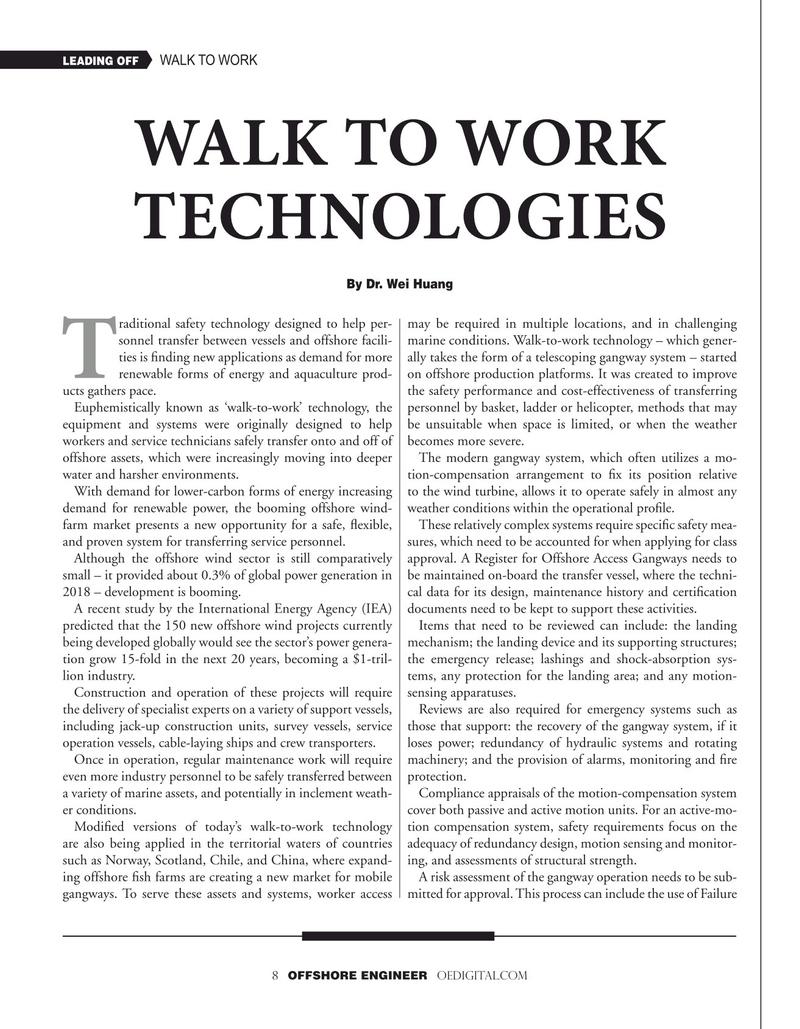
Page 8: of Offshore Engineer Magazine (May/Jun 2020)
Read this page in Pdf, Flash or Html5 edition of May/Jun 2020 Offshore Engineer Magazine
LEADING OFF WALK TO WORK
WALK TO WORK
TECHNOLOGIES
By Dr. Wei Huang raditional safety technology designed to help per- may be required in multiple locations, and in challenging sonnel transfer between vessels and offshore facili- marine conditions. Walk-to-work technology – which gener- ties is fnding new applications as demand for more ally takes the form of a telescoping gangway system – started
T renewable forms of energy and aquaculture prod- on offshore production platforms. It was created to improve ucts gathers pace. the safety performance and cost-effectiveness of transferring
Euphemistically known as ‘walk-to-work’ technology, the personnel by basket, ladder or helicopter, methods that may equipment and systems were originally designed to help be unsuitable when space is limited, or when the weather workers and service technicians safely transfer onto and off of becomes more severe.
offshore assets, which were increasingly moving into deeper The modern gangway system, which often utilizes a mo- water and harsher environments. tion-compensation arrangement to fx its position relative
With demand for lower-carbon forms of energy increasing to the wind turbine, allows it to operate safely in almost any demand for renewable power, the booming offshore wind- weather conditions within the operational profle. farm market presents a new opportunity for a safe, fexible, These relatively complex systems require specifc safety mea- and proven system for transferring service personnel. sures, which need to be accounted for when applying for class
Although the offshore wind sector is still comparatively approval. A Register for Offshore Access Gangways needs to small – it provided about 0.3% of global power generation in be maintained on-board the transfer vessel, where the techni- 2018 – development is booming. cal data for its design, maintenance history and certifcation
A recent study by the International Energy Agency (IEA) documents need to be kept to support these activities. predicted that the 150 new offshore wind projects currently Items that need to be reviewed can include: the landing being developed globally would see the sector’s power genera- mechanism; the landing device and its supporting structures; tion grow 15-fold in the next 20 years, becoming a $1-tril- the emergency release; lashings and shock-absorption sys- lion industry. tems, any protection for the landing area; and any motion-
Construction and operation of these projects will require sensing apparatuses. the delivery of specialist experts on a variety of support vessels, Reviews are also required for emergency systems such as including jack-up construction units, survey vessels, service those that support: the recovery of the gangway system, if it operation vessels, cable-laying ships and crew transporters. loses power; redundancy of hydraulic systems and rotating
Once in operation, regular maintenance work will require machinery; and the provision of alarms, monitoring and fre even more industry personnel to be safely transferred between protection. a variety of marine assets, and potentially in inclement weath- Compliance appraisals of the motion-compensation system er conditions. cover both passive and active motion units. For an active-mo-
Modifed versions of today’s walk-to-work technology tion compensation system, safety requirements focus on the are also being applied in the territorial waters of countries adequacy of redundancy design, motion sensing and monitor- such as Norway, Scotland, Chile, and China, where expand- ing, and assessments of structural strength. ing offshore fsh farms are creating a new market for mobile A risk assessment of the gangway operation needs to be sub- gangways. To serve these assets and systems, worker access mitted for approval. This process can include the use of Failure 8 OFFSHORE ENGINEER OEDIGITAL.COM

 7
7

 9
9